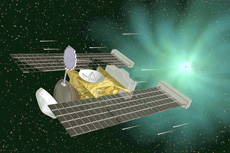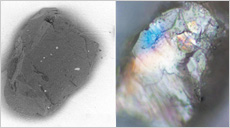Q. Of those results, what has most captured your interest?

Itokawa’s Muses Sea (the smooth area near the center), where HAYABUSA collected its sample
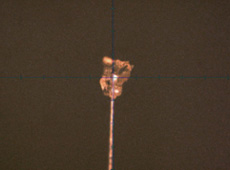
Optical microscope photo of Itokawa dust particles supported by 5-µm-diameter carbon fibers (courtesy: Osaka University/JAXA)
For me, it’s the amazing amount of information such tiny samples hold about the heating history of the asteroid. The first analysis shows that the sample of Itokawa heated to 800 degrees Celsius. The asteroid formed from smaller objects; each of these impacts made the asteroid larger and larger and caused heat to accumulate inside the asteroid, changing kinetic energy to thermal energy. So as the asteroid was growing, it was heating up. And the minerals in the samples returned by HAYABUSA record every stage of this heating process, and also the cooling, down to the present temperature today. All those steps are recorded in different minerals. And by careful analysis of these tiny mineral grains in the HAYABUSA samples, you can map out the heating history and then the cooling history of the asteroid very, very accurately.
Q. What is the charm of the sample of Itokawa?
Although we have tens of thousands of meteorites from asteroids, they tell us almost nothing about what’s happening at the very surface of the asteroids. And for the past 4.6 billion years, that’s where all the activity has been on these asteroids. The interactions with other kinds of asteroids, impacts, interactions with the sun and radiation, comets striking the asteroid – all that information is really found only on the very surface of the asteroid. That’s one of the most valuable aspects of the Itokawa samples. In addition, it’s possible that the Itokawa dust may contain particles that fell from other small objects, so we may be able to learn about asteroids that are of a different type from Itokawa. We’ve learned a lot from the meteorites we already have. But we’re learning a lot more from the dust.
This is why the Itokawa sample has so much vital information in it. It’s only been a year since we began the Itokawa analyses, but we’ve already learned a lot, and there’s still much, much more we can learn. And that’s the value of having your samples on Earth carefully curated and maintained as they are here, by JAXA, in a very clean, carefully controlled environment. It’s worth doing that because some of our children and our grandchildren will be scientists, and will want to study these samples. And if we’re careful with the samples now, they’ll be safe, and future scientists who are asking new questions with new equipment that doesn’t even exist now will have these samples as a resource to use. So it’s an international treasure that’s being cared for here by JAXA.
Q. You took part in the recovery of the HAYABUSA capsule in Australia, and in the work at JAXA’s curation facility. What was your impression of those operations?

Work using JAXA’s curation equipment
First of all, I want to say that it’s a great honor to be even just a tiny part of this mission. People in Japan should be very proud of the scientists and engineers that are working here. They really pulled off a miracle in this mission.
I was very fortunate to be part of the HAYABUSA capsule recovery team that was in Australia in June, 2010. It was truly one of the most exciting things I’ve ever done. Watching the spacecraft come into the atmosphere at night, it was actually red – bright red, glowing. It was fantastic.
In fact, I was also on the recovery team for NASA’S Stardust Mission. And this was actually, I think, a better recovery operation than we had for Stardust. It’s just amazing. It was great to see how carefully people here had prepared for recovery day. They were prepared for anything that could happen. And nothing went wrong. Everything happened just right because people planned this very, very carefully.
And then, of course, it took a long time to remove the samples from the sample catcher inside the spacecraft because they were so tiny and hard to see. And again, people here had spent years preparing to do that. But even so, they had to adjust and adapt techniques to the actual samples. It took quite a bit of time to do that – you had to be very careful not to lose any of these tiny, precious samples. They devised entirely new techniques for handling these particles. And then they had to move them around without losing them. And then to learn the most you could from these precious samples. That was really thrilling. So to be just a small part of that was an honor for me.
Actually we were at JAXA’s curation facility for a month to learn how to handle the particles. I advised the HAYABUSA team based on my experience with the Stardust mission, but I could not handle the sample, because I was afraid to do that, I was afraid I might lose the sample. And now we can apply techniques developed here for HAYABUSA and bring them back to America and apply them to other samples – to asteroid and comet grains collected in Earth’s stratosphere and to the Stardust samples from Comet Wild 2.
Q. What kind of asteroid exploration missions are making progress in the United States?
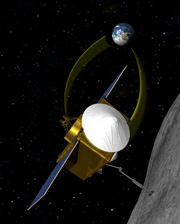
Asteroid Explorer OSIRIS-REx (courtesy: NASA/Goddard/University of Arizona)
Right now, the United States has a plan to send a new spacecraft, called OSIRIS-REx, to a primitive, perhaps organic-rich asteroid called 1999 RQ36. OSIRIS-REx will be launched in 2016, and we hope to get some organics from the earliest stage of the solar system. The hope is that those samples will tell us about the precursors to life on Earth, because all those organic molecules and water were raining down on the early Earth. All the things that are in our bodies came from those asteroids, and from comets as well. The challenge will be to clean up the spacecraft so you don’t contaminate the asteroid. And then, how do you clean up the collection part of the spacecraft so the samples are maintained without any organics being introduced from the air. It also means that when you bring it back to Earth, the laboratory has to be organically clean, which is a very, very difficult thing to do. Because we humans are lumps of organic matter.
Japan’s HAYABUSA 2, which will launch in 2014, also plans to go to a more primitive and, we think, more organic-rich asteroid. One of the main goals of OSIRIS-REx and HAYABUSA 2 is the sample return of organic matter. And so because these missions have similar goals, of course people are discussing how to clean up the spacecraft and maintain them cleanly, how to function at the asteroid, how to do preliminary analyses of the samples without contaminating them, etc. That’s very, very important. And also mistakes. If you make a mistake in your mission, you tell the other mission, “Oh, we did this thing wrong, please avoid this mistake.” That’s really an important thing that often doesn’t get done. People don’t talk to each other. So it’s important that it happen this time. I’d certainly like the relationships I’ve built with Japanese researchers through the HAYABUSA mission to also be of help in future missions.
Q. What are you hopes for future asteroid exploration?
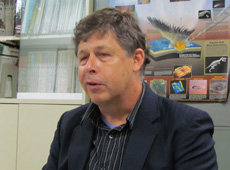
I might say that I like studying water in every solar system. In 1998 I found a meteorite that fell in Texas with halite (table salt) crystals inside, which contained droplets of liquid water inside. And my hope is that we return more of that kind of material in a future mission. Or maybe even ice. People are thinking about how you would collect a sample of ice on an icy asteroid or a comet, and then keep it frozen all the way back to Earth. It would be very hard to do, but you could do it. So my dream is that in my lifetime, sometime, we’ll be able to have the chance to do a mission where we bring back actual ice from a comet or an asteroid. Maybe it could still happen during my career.
Cosmic Mineralogist, Astromaterials Research and Exploration Science Directorate, NASA
Dr. Zolensky earned a Ph.D. in Geochemistry and Mineralogy from Pennsylvania State University in 1983. Since 1985, he has worked at NASA’s Johnson Space Center, conducting research on Moon samples provided by the Apollo program and on the mineralogy of meteorites and interplanetary dust, in addition to developing analytical equipment and sample return techniques for extraterrestrial materials. He has been involved in investigating numerous meteorites, as well as sample collection and analysis for the Stardust comet probe and the HAYABUSA asteroid probe. His research specialty is the mineralogy of extraterrestrial materials.
HAYABUSA’s Challenge
Asteroids: The Primitive Objects in the Solar System
Using Oxygen to Trace the Origins of Meteorites
Particles from Itokawa: A Treasure for the World

